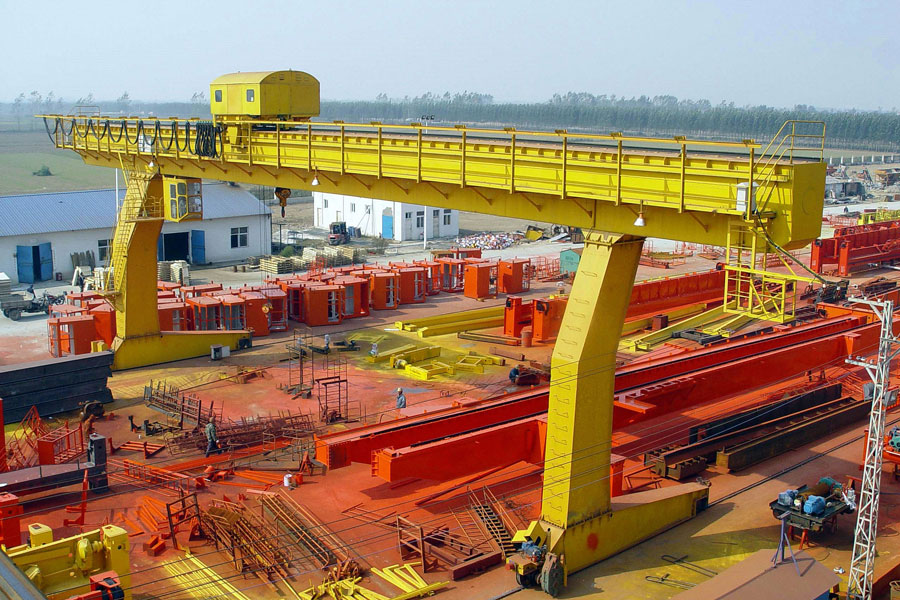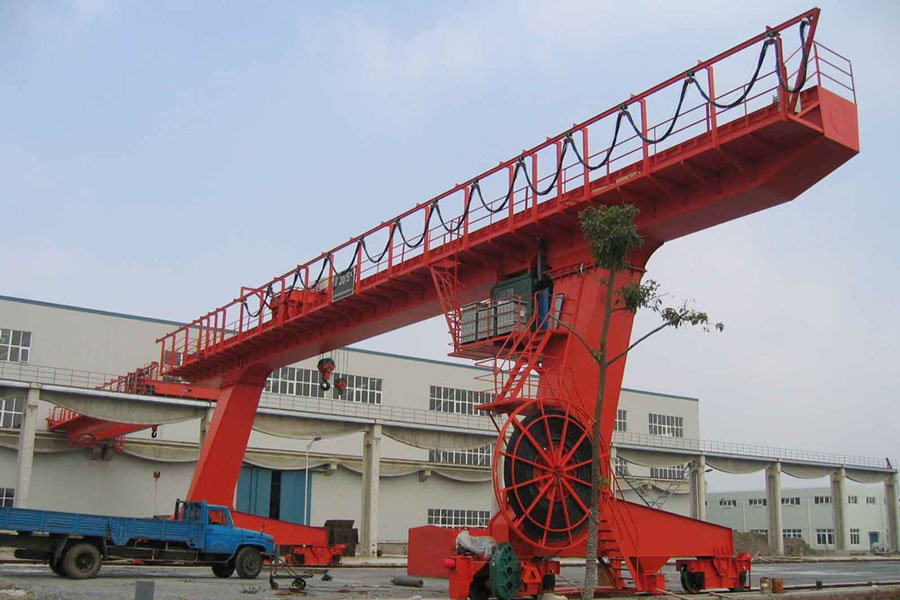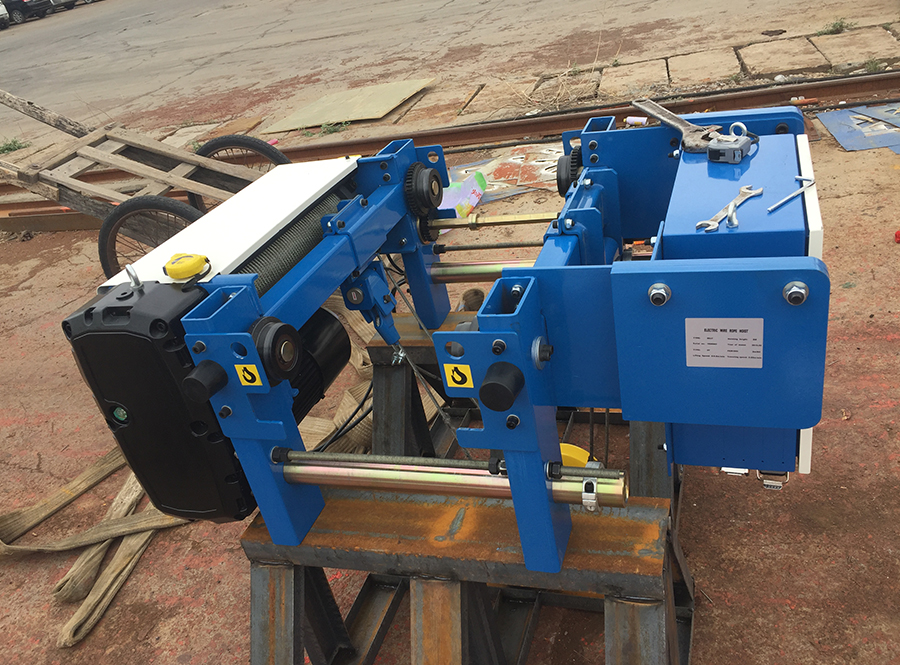Kren gantri luar ialah kren yang direka untuk digunakan dalam persekitaran luar seperti tapak pembinaan, halaman dan gudang. Ia biasanya digunakan untuk mengangkat dan memindahkan objek dan bahan berat. Adalah penting untuk ambil perhatian bahawa ciri khusus dan reka bentuk kren gantri luar mungkin berbeza-beza bergantung pada pengilang dan aplikasi yang dimaksudkan. Berikut akan memperkenalkan secara terperinci penyediaan pra-pembinaan dan proses pemasangan kren gantri luar yang dipasang di rel untuk dijual.
1. Preparation before construction
① The construction site must be hardened in advance. The site is open and there are no obstacles interfering with the installation and construction. The foundation of the crane working area is solid and reliable.
② The construction of the CE approved outdoor kren gantri price traveling line has been completed and passed the acceptance inspection.
③Construction personnel must be familiar with the construction site and this installation plan, and technical personnel must make technical safety briefings on the construction process.
④ Conduct qualification review and technical safety briefing on the cranes and personnel who cooperate with the installation, and conduct comprehensive inspections on the machinery and equipment.
⑤ Conduct a comprehensive inspection of all tools used for installation work. All safety devices must be complete and reliable.
⑥Seat belts, speed differential protectors, and safety ropes used in operations should be inspected and qualified.
⑦All construction workers must wear safety protective equipment.
⑧ Define the work scope as a warning area, and non-gantry crane installation and construction personnel are strictly prohibited from entering.
2. Overall installation steps
Start → Track re-inspection → Main beam assembly → Walking lower beam installation → Connect the outriggers and walking lower beam → Integrated lifting gantry crane → Connect the outriggers and main beam → Operation room installation → Electrical system installation → Safety device installation → Whole machine inspection → No-load debugging → load test → end
[Specific construction procedures]
Track re-inspection

(1) The track should be reliably fixed, the bolts must not be loose, the pressure plate must not be deformed, and the rail surface must not have cracks, scars, or defects that affect safe operation;
(2) The gauge error between the two tracks shall not be greater than 10mm;
(3) The longitudinal inclination of the top surface of the track is not greater than 3/1000, and the height difference within the full stroke is not greater than 10mm, and the relative elevation difference between two parallel rails within the same section is not greater than 10mm;
(4) The track joints adopt a butt arrangement;
(5) The height difference and misaligned teeth at the track joint should not be greater than 1mm;
Main beam assembly of european standard kren gantri luar
The 12-meter-span main beam is directly lifted to the predetermined lifting position. After the outriggers are assembled, a crane is used to lift it directly to the installation position.
For the 24-meter-span 25-ton and 100-ton main beams, use a crane to lift the left half of the main beam to the predetermined position. After the position is reached, adjust the support pads, and then use wooden squares to support both sides. After they are stable and upright, proceed in sequence. The support pad fixing work for the right half of the main beam. After the above is completed, the main beam connection is carried out, and then the main beam is monitored.
Installation of cross beam under walking
Use a crane to lift the lower traveling beam onto the track, and then tighten the rail clamp. Use sleeper pads for the gearbox on the side of the trolley, and use square timbers on both sides of the traveling beam to support it firmly, and ensure that the traveling beam is vertical.
Connect the outriggers to the walking lower beam
Use a crane to lift the outriggers to the end of the walking lower beam for installation. The flange should correspond to the factory number. Tighten the bolts and pull the wind cable. Adjust the tightness of the chain hoist and measure and correct the verticality of the legs.
Main beam lifting of
chinese supplier outdoor gantry crane cost
The main beam of the 12-ton 12-meter span gantry crane is installed using a 30-ton crane to lift the main beam as a whole. The crane arm length is 17.3 meters, the working radius is 6 meters, the rated lifting weight is 13.65 tons, the total weight of the main beam is about 10 tons, and a single crane is lifted in the center Fully meet competency requirements.
The main beam of the 25-ton 24-meter-span gantry crane is installed using an 80-ton crane to lift the main beam as a whole. The crane arm length is 24 meters, the working radius is 6 meters, the rated lifting weight is 32 tons, the total weight of the main beam is about 22 tons, and the center of a single crane Lifting fully meets capacity requirements.
The main beam of the 100-ton 24-meter span gantry crane is installed using two 80-ton cranes to lift the main beam. The crane arm is 18 meters and the working radius is 6 meters. The rated lifting weight of a single unit is 34.3 tons. The total lifting weight of the two units is 68.6 tons. The total weight of the beam is about 52 tons, and two cranes are used to lift the beam to fully meet the lifting requirements.
Before lifting, review the working position and working radius of the crane, check the corners of the main beam lifting points and binding points, and remove all obstacles. When lifting a bicycle, the crane must be operated by a general commander and a supervisor. The crane must be lifted 10cm from the ground and observed for 5 minutes. The weight of the bridge frame and the load-bearing rate of the crane shall be reviewed. If the review is qualified, the main beam shall be placed on the ground. Re-test the crane brake system. After checking that there are no abnormal problems, the crane can be lifted. The commander and supervisors should observe closely to ensure that the entire main beam remains level and lifts smoothly. When the main beam is lifted to a position higher than the outriggers, stop lifting. , slew the crane until the outriggers are aligned with the connecting flange of the main beam for connection. During the entire lifting process, the crane’s lifting rope and hook must always remain vertical.

When lifting beams on two vehicles, there is one chief guide and three guardians on the crane. The two crane points are chosen to be symmetrical to keep the lifting weights of the two vehicles balanced. Obey the commander’s command and lift about 10cm from the ground at the same time. Observe stationary for 5 minutes to check the hoisting of the two vehicles. Whether it is balanced, whether the angle of the wire rope meets the requirements, and the braking system is checked. After checking that there is no abnormality, the crane starts lifting. The commander and supervisor should observe closely to keep the lifting speed of the two vehicles consistent, so that the entire main beam can be lifted horizontally and steadily. When the beam is lifted to a position above the outriggers, stop lifting and rotate the crane until the outriggers are aligned with the connecting flange of the main beam for connection. During the lifting process, the movements of the two vehicles must be consistent and coordinated.
Operation room installation
Use a crane to lift the operating room to the designed position, and connect it after precise alignment.
Electrical system installation
Connect the cables from the operating room to the motors of the two traveling platform beams in sequence, reserve cable joints for the remaining motors and safety devices, and connect the reel cables to the operating room and secondary disk.
Improvement and adjustment of various safety devices
The safety devices of the gantry crane mainly include the lifting weight limiter, hook height limiter, travel limiter, rail sweeper and end gear, etc. The comprehensive error of adjusting the lifting weight limiter is ±5%, and the display error is ≤5%. Adjust the travel limiter so that its limit position is 2 meters away from both ends. Adjust the hook height limit so that its action position is about 2 meters away from the main beam.
3. Whole machine debugging
Preparation and inspection before commissioning
(1) Check the entire machine according to the drawing size and technical requirements: whether each fastener is firm, whether each transmission mechanism is accurate and flexible; whether the metal structure is deformed, whether the wire rope is wound correctly, and whether the rope ends are tied firmly.

(2) Check whether the crane assembly meets the requirements.
(3) Use a megameter to check the insulation resistance of all electrical systems and all electrical equipment; cut off the circuit, check whether the control circuit is correct and whether the moving parts of all control equipment are flexible and reliable, and lubricate if necessary; turn all parts of the crane by hand, There should be no jamming.
No load test run
After the above inspection, after the whole machine is normal and there is no jamming, the no-load test run can be carried out. Proceed as follows:
a. Hoisting and driving test: The unloaded electric hoist runs back and forth along the rail car three times. At this time, the wheels should not have obvious slippage, and the wheels should brake smoothly and reliably.
b. Empty hook lifting: raise and lower the empty hook three times each, and the lifting limit should be accurate.
c. Stop the electric hoist at the root of the main beam and make the cart slowly walk twice along the entire length of the longitudinal track to verify the track. Then walk back and forth three times at the rated speed to check the working quality of the operating mechanism. When starting and braking, the wheels should not slip and run smoothly.
Load test run
After the no-load test run is normal, load test run is allowed. Load test run is divided into two types: static load test run and dynamic load test run.
[Technical requirements for load testing]
a. The welding and bolt connection quality of the crane’s metal structure should meet the technical requirements.
b. The strength and toughness of mechanical equipment, metal structures, and spreaders should meet the requirements.
c. The brake is flexible in action, the reducer is noiseless and works reliably.
d. The lubricating parts are well lubricated, and the bearing temperature rise does not exceed the regulations.
e. All mechanical movements are smooth, without severe vibration and impact. If there are any defects, they should be repaired before testing.
[Static load test run]
The electric hoist lifts the rated load. After traveling back and forth on the main beam several times, run the electric hoist to the middle of the span, lift the weight to a certain height, and let it sit for 10 minutes. At this time, measure the lower deflection of the main beam. After three consecutive tests, and after the load is removed for the third time, the main beam shall not have residual deformation, and each test time shall not be less than 10 minutes.
After the above test, a 20% over-rated load test can be carried out. The methods and requirements are the same as above.
[Dynamic load test run]
Only after passing the static load test can the dynamic load test be carried out.
Lift the rated load of the electric hoist for repeated lifting and lowering braking tests, and then start the fully loaded electric hoist to walk back and forth along the track 3 to 5 times. Finally, drive the fully loaded electric hoist to the root of the mast, allow the crane to travel back and forth with the trolley track at rated speed 2 to 3 times, and brake and start repeatedly. At this time, the brakes, limit switches and electrical operations of the mechanism should be reliable, accurate and flexible, the wheels should not slip, the frame vibration should be normal, the mechanism should run smoothly, and there should be no residual deformation of the mechanism and frame after unloading.
The above test results are good, and a 10% overload test can be carried out. The test items and requirements are the same as above. After passing all tests, it can be used only after it is reported to the professional department for inspection and passed.






















